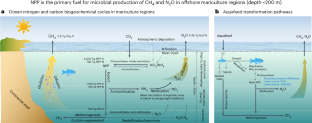Marine aquaculture can deliver 40% lower carbon footprints than freshwater aquaculture based on feed, energy and biogeochemical cycles
IF 23.6
Q1 FOOD SCIENCE & TECHNOLOGY
引用次数: 0
Abstract
Freshwater aquaculture is an increasingly important source of blue foods but produces substantial methane and nitrous oxide emissions. Marine aquaculture, also known as mariculture, is a smaller sector with a large growth potential, but its climate impacts are challenging to accurately quantify. Here we assess the greenhouse gas emissions from mariculture’s aquatic environment in global potentially suitable areas at 10 km resolution on the basis of marine biogeochemical cycles, greenhouse gas measurements from research cruises and satellite-observed net primary productivity. Mariculture’s aquatic emissions intensities are estimated to be 1–6 g CH4 kg−1 carcass weight and 0.05–0.2 g N2O kg−1 carcass weight, >98% and >80% lower than freshwater systems. Using a life-cycle assessment approach, we show that mariculture’s carbon footprints are ~40% lower than those of freshwater aquaculture based on feed, energy use and the aquatic environment emissions. Adoption of mariculture alongside freshwater aquaculture production could offer considerable climate benefits to meet future dietary protein and nutritional needs. Combining observations and biogeochemical theories, mariculture greenhouse gas emissions are estimated in comparison with freshwater aquaculture. Climate-friendly farm designs, species selection and low-density operational practices can mitigate damage to marine ecosystems and avoid carbon loss.


基于饲料、能源和生物地球化学循环,海水养殖的碳足迹可比淡水养殖低 40
淡水养殖是日益重要的蓝色食品来源,但会产生大量甲烷和氧化亚氮排放。海水养殖(又称海产养殖)是一个规模较小、增长潜力巨大的行业,但其对气候的影响却难以准确量化。在此,我们根据海洋生物地球化学循环、研究考察船的温室气体测量结果以及卫星观测到的净初级生产力,以 10 千米的分辨率评估了全球潜在适宜区域海水养殖水生环境的温室气体排放量。据估计,海水养殖的水生排放强度为 1-6 g CH4 kg-1 体重和 0.05-0.2 g N2O kg-1 体重,分别比淡水系统低 98% 和 80%。我们使用生命周期评估方法表明,根据饲料、能源使用和水生环境排放,海水养殖的碳足迹比淡水养殖低约 40%。在淡水水产养殖生产的同时采用海水养殖可提供可观的气候效益,以满足未来的膳食蛋白质和营养需求。
本文章由计算机程序翻译,如有差异,请以英文原文为准。
求助全文
约1分钟内获得全文
求助全文

 求助内容:
求助内容: 应助结果提醒方式:
应助结果提醒方式:


